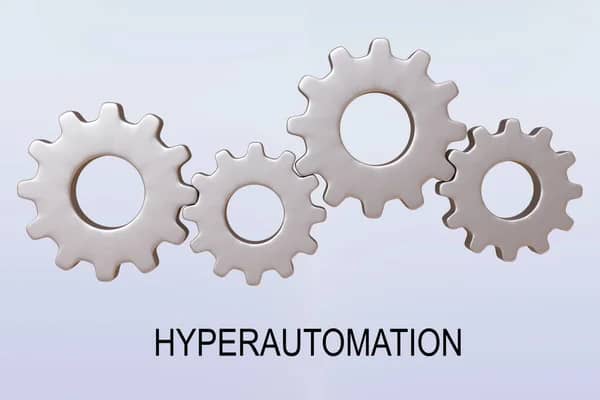In a rapidly changing digital world, tech application and businesses need to stay ahead of the curve in order to remain competitive.
For this reason, Hyperautomation is becoming increasingly popular as a way for tech companies to increase efficiency and productivity.
In the next six years Hyperautomation is expected to have reached its peak, with a global market share size that is estimated to be about $120 billion.
By this period, it is expected that organizational monitoring, analysis, design, measurement, and reassessment of processes by the use of AI and Machine learning must have been fully exploited.
Over the years, we’ve seen tech companies like UiPath and IBM offering topnotch tech application and hyper automation services to Manufacturing industries and corporations to foster the growth and development in almost every area of their businesses.
We all know about Hyperautomation, but let’s quickly find out how the big tech-companies are taking advantage of hyper-automation and what it could mean for your business.
Hyperautomation And Its Application

Hyperautomation is practically the process of automating all business processes. This can include everything from customer relationship management (CRM) to supply chain management (SCM).
It is often implemented using a combination of robotic process automation (RPA), artificial intelligence (AI), and machine learning (ML).
The goal of hyper-automation is to reduce the need for human intervention in business processes.
of course, this helps to automate as many tasks as possible, so that businesses can improve efficiency and accuracy, while also reducing costs.
The tech application of Hyperautomation has already been adopted by some of the world’s largest companies, including Amazon, Google, and Facebook.
Due to the positive results acquired from its use, a lot of small and medium enterprises have been leveraging the use of its tech application to scale their businesses rapidly and efficiently.
Benefits of Hyperautomation
There are many benefits of Hyperautomation, but here are a few of the most important ones:
1. Increased Efficiency And Productivity
By automating tasks typically performed by humans, you can dedicate fewer tasks to your employees to focus on more strategic initiatives. This can lead to increased efficiency and productivity overall.
2. Saving Of Costs
Hyperautomation can also help you save money. By eliminating the need for excessive human workforce to perform certain tasks, you can reduce your labor costs.
Additionally, the tech application of automating repetitive tasks can help you avoid mistakes that could end up costing your company money.
3. Improved Customer Service
Customers today expect around-the-clock service and immediate responses to their inquiries. Hyperautomation can help you meet these expectations by automating customer service tasks like responding to support tickets or live chat messages.
This can lead to happier customers and improved customer retention rates.
Why Do Companies Need Hyperautomation?
In recent years, more companies have been leveraging the use of Hyperautomation for the increase in efficiency and productivity of their businesses.
While automating tasks that are typically performed by humans, corporations can reduce costs through the increase in efficiency and productivity.
For example, Amazon has been using Hyperautomation to automate its warehouses and fulfillment centers. By doing so, the company can fulfill orders faster, with fewer errors.
Similarly, Google has been using Hyperautomation to improve the quality of its search results.
By automating the process of crawling and indexing websites, it has been observed that there has been a significant change in the way Google provides users with more relevant and accurate search results.
Generally, Hyperautomation is a powerful tool that can be used by tech companies to increase efficiency and productivity.
By automating tasks that are typically performed by humans, these companies can save time and money while providing better products and services to their customers.
The Merits and Shortcomings of Hyperautomation
The advantages of Hyperautomation include:
1. Increased efficiency and productivity: When tasks are automated, they can be completed faster and with greater accuracy. This can free up employees to focus on more strategic tasks.
2. Cost savings: Automating tasks can help reduce labor costs.
3. Improved customer satisfaction: the tech application of automating processes can help improve the quality and speed of service delivery, leading to happier customers.
4. Reduced risks: Automating tasks can help reduce the potential for human error, which can lead to costly mistakes.
The Setbacks of Using Hyperautomation include:
1. Job loss concerns: There is a fear that automating tasks will lead to job losses, as machines will replace human workers. However, it’s important to note that automation often leads to the creation of new jobs, as well as the need for workers with new skill sets.
2. Implementation challenges: Implementing Hyperautomation can be complex and challenging, requiring significant investments in time and resources.
3. Ethical concerns: As automated systems become increasingly sophisticated, there are ethical concerns about giving machines too much power over decision-making processes
Some Known Challenges of Implementing Hyperautomation

Hyperautomation is not without its challenges. One of the key challenges is its potential to disrupt existing business models and processes.
Many organizations are still reliant on manual processes and traditional ways of working. Hyperautomation can automate these processes, but it can also cause significant disruption in the organization.
Another challenge is the lack of skills and experience in its implementation. Many organizations do not have the necessary skills or experience to implement Hyperautomation effectively. This can lead to problems and delays.
Finally, it can be expensive. The cost of implementing Hyperautomation is largely significant, especially for large organizations. This makes it difficult to justify the investment, particularly in the current economic climate.
RELATED TOPIC: WHAT TO EXPECT FROM 6G TECHNOLOGY
GO BACK HOME TO CHECK RELATED TOPICS!!
Use Cases of Hyperautomation
There are many potential use cases for Hyperautomation, but some of the most common and impactful applications are in the areas of customer service, finance, and human resources.
In customer service, Hyperautomation is used to automate repetitive tasks such as responding to common inquiries, routing customer requests, and escalations.
This can free up customer service representatives to provide higher-level support and improve the overall customer experience.
In the Finance department, companies can streamline accounting and financial reporting processes. It can also be used to detect and prevent fraud, waste, and abuse.
By automating these processes, organizations can improve accuracy and efficiency while reducing costs.
In human resources, hyperautomation can be used to automate tasks such as onboarding new employees, tracking employee performance, and managing benefits enrollment.
This can help organizations manage their workforce more effectively and improve employee satisfaction.
Conclusion
Hyperautomation is transforming the way big tech companies operate, from automating mundane tasks to improving customer service.
It is also helping these companies remain competitive in a digital world and saving them time, money, and resources.
The adoption of Hyperautomation across industries will not only improve efficiency but also create new opportunities for business growth.
As more businesses embrace automation, its importance cannot be overstated, and it should continue to play an integral role in how we work going forward.


